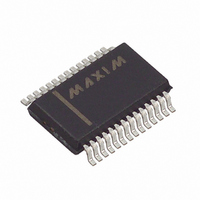MAX1403EAI+ Maxim Integrated Products, MAX1403EAI+ Datasheet - Page 22

MAX1403EAI+
Manufacturer Part Number
MAX1403EAI+
Description
IC ADC 18BIT LP 28-SSOP
Manufacturer
Maxim Integrated Products
Datasheet
1.MAX1403EAI.pdf
(36 pages)
Specifications of MAX1403EAI+
Number Of Bits
18
Sampling Rate (per Second)
480
Data Interface
QSPI™, Serial, SPI™
Number Of Converters
1
Power Dissipation (max)
21.45mW
Voltage Supply Source
Analog and Digital
Operating Temperature
-40°C ~ 85°C
Mounting Type
Surface Mount
Package / Case
28-SSOP
Number Of Adc Inputs
5
Architecture
Delta-Sigma
Conversion Rate
4.8 KSPs
Resolution
18 bit
Input Type
Voltage
Interface Type
Serial
Voltage Reference
External
Supply Voltage (max)
3 V
Maximum Power Dissipation
21.45 mW
Maximum Operating Temperature
+ 85 C
Mounting Style
SMD/SMT
Input Signal Type
Pseudo-Differential, Differential
Minimum Operating Temperature
- 40 C
Lead Free Status / RoHS Status
Lead free / RoHS Compliant
+3V, 18-Bit, Low-Power, Multichannel,
Oversampling (Sigma-Delta) ADC
Table 12. Input Channel Configuration in Fully Differential and Pseudo-Differential
Mode (SCAN = 0)
X = Don’t care
* This combination is available only in pseudo-differential mode when using the internal scanning logic.
** These combinations are only available in the calibration modes.
22
DS1, DS0: The status of the auxiliary data input pins.
These are latched on the first falling edge of the SCLK
signal for the current data register read access.
CID2–0: Channel ID tag (Table 11).
A switching network provides selection between three
fully differential input channels or five pseudo-differen-
tial channels, using AIN6 as a shared common. The
switching network provides two additional fully differen-
tial input channels intended for system calibration,
which may be used as extra fully differential signal
Table 11. Channel ID Tag Codes
CID2
M1
______________________________________________________________________________________
0
0
0
0
0
0
1
0
0
0
0
1
0
0
0
0
1
1
1
1
CID1
M0
0
0
0
0
0
1
0
0
0
0
1
0
0
0
1
1
0
0
1
1
DIFF
CID0
X
X
X
X
X
0
0
0
0
1
1
1
0
1
0
1
0
1
0
1
Switching Network
A1
X
X
X
X
X
0
0
1
1
0
0
1
CHANNEL
AIN1–AIN6
AIN2–AIN6
AIN3–AIN6
AIN4–AIN6
AIN1–AIN2
AIN3–AIN4
AIN5–AIN6
Calibration
A0
0
1
0
1
X
X
X
0
1
0
X
X
channels. Table 12 shows the channel configurations
available for both operating modes.
To sample and convert the available input channels
sequentially, set the SCAN control bit in the global
setup register. The sequence is determined by DIFF
(fully differential or pseudo-differential) and by the
mode control bits M1 and M0 (Tables 8, 9, 10). With
SCAN set, the device automatically sequences through
each available channel, transmitting a single conver-
sion result before proceeding to the next channel. The
MAX1403 automatically allows sufficient time for each
conversion to fully settle, to ensure optimum resolution
before asserting the data-ready signal and moving to
the next available channel. The scan rate is, therefore,
dependent on the clock bit (CLK), the filter control bits
(FS1, FS0), and the modulator frequency selection bits
(MF1, MF0).
The input circuitry also provides two “burn-out” cur-
rents. These small currents may be used to test the
integrity of the selected transducer. They can be selec-
tively enabled or disabled by the BOUT bit in the global
setup register.
Differential
Differential
Pseudo-
MODE
Fully
CALGAIN+**
CALGAIN+**
HIGH INPUT
CALOFF+**
CALOFF+**
AIN5*
AIN1
AIN2
AIN3
AIN4
AIN1
AIN3
AIN5
Scanning (SCAN-Mode)
Burn-Out Currents
LOW INPUT
CALGAIN-**
CALGAIN-**
CALOFF-**
CALOFF-**
AIN6*
AIN6
AIN6
AIN6
AIN6
AIN2
AIN4
AIN6











